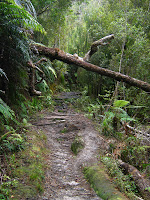1. Shifting with my left hand.
This is actually a proxy for all the things I will miss about driving in New Zealand. First, my current Ohio car is my first automatic transmission; arriving in NZ and going back to standard was great. Second, shifting gears with the left hand is a consequence of driving on the left-hand side of the road, which makes driving a lot more interesting because (in addition to shifting), I’ve got things to think about. Third, the gear shift belongs to my hired Daihatsu Sirion, which from American eyes looks small enough to fold up and put your pocket. In New Zealand, it’s smallish but not freakishly so, and by no means the smallest thing on the road. Vans, SUVs, trucks, and other large vehicles are a MINORITY. Even the shipping trucks are mostly small. It makes it so much easier to see the road! Last, the roads are curvy enough to need lots of shifting!
2. Topography
Anyone living in northwest Ohio will recognize the dearth of elevation changes that region affords. (Unless they possibly have never been anywhere else, in which case a 30-foot hill probably is a mountain.) I never got lost in Christchurch, because the Port Hills are clearly visible from wherever you are. It's possible to actually see across town. On my drive south to the office, I could see west as far as the Southern Alps. From in the Port Hills, you get a huge panoramic view. Ocean to 12,000 feet, all within seeing distance. Bonus: right now the mountains have a pretty dusting of snow on them.
3. Fall weather
The southern hemisphere is actually in the depths of its winter, and the days are incredibly short. However, New Zealand’s island nature tempers the cold weather close to sea level, so I’ve been enjoying 40- and 50-degree days. In addition, the weather is so mercurial, that there’s very rarely something so dismal as a bad-weather day. Fronts don’t take days to pass over a region—they can pass over the entire country in less than 24 hours. If it was raining in the morning, odds were good the sun would be out before the afternoon finished. Since the one thing I managed to lose this trip was my raincoat, this is a Good Thing.
4. Hagley Park
The park is one of the largest inner city parks in the world (as any tour guide will tell you). The perimeter walk is about 6-7 km, and smack in the middle of the park is the Botanic Garden. (The Botanic Garden contains the Rose Garden, which I've mentioned before.) There are always people in the park—many runners and walkers, rugby and netball players, sometimes cricketers, too. Helicopters landed on the south park lawn (especially after the earthquake) and the north grounds transformed from flower show to memorial celebration site to kidfest to rugby fan zone just while I was here. I walked around this park enough times to consider some of the trees as personal friends (especially on the rainy mornings). I even pilfered a rock from the park when I needed something to open walnuts. Of all the places in Christchurch outside my little rented room, I visited this one the most.
5. The local market
Veggie growers are set up on the grounds of Riccarton House every week, year round, selling local in-season produce. A trip to the market meant a lovely walk to (and through) a historic site with fresh food as a bonus. The grounds have a pest-proof fenced off area of native bush where there are always birds--some of which I managed to see if I sat still long enough. If I got up early enough in the morning, the specialty bread people still had scones by the time I arrived. My personal favourite: the wine purveyors who also sold ripe grapefruits they’d just picked off their tree (never tried their wine).
6. Indian takeaway
Technically I suppose I could get Indian takeaway if I drove the 30-odd minutes it takes to get from Tiffin to Findlay. But it’s so much better if you can phone in the order and it’s ready by the time you walk to the restaurant, where the owner knows your name and how you like your sauce…
7. The CQ Digital Printing window
Ads show up in NZ just like they do in the US: posters, billboards, tv, magazines, the lot. There's even a lot of similar humour in them. This printing business put a local spin on their window: a big cartoon head (called Collette) with a huge cartoon bubble coming from her mouth. Every week she had something different to say, often related to the trials and tribulations of living in the earthquake zone Christchurch had become. CQ took suggestions from the public; who knows how many they used. If my regular walking routine didn't take me by that window during the week, I would detour, just for a quick chuckle.
I managed to fit about 25 other things on the post-it I was using—many of them food-related. There are some things I’ve been doing to try to mitigate the pain of leaving. I’m coming home with a cookbook and a set of metric measuring implements. I’ve also taken thousands of photos, some of which I have actually labeled. I have addresses of people and websites to stay in touch with the region. What is sad is much of the day-to-day stuff will gradually fade from memory with passing time… The only way I’m managing to say goodbye to all of this is to reassure myself that it isn’t forever; I’ll be coming back.










